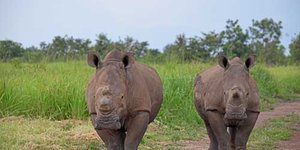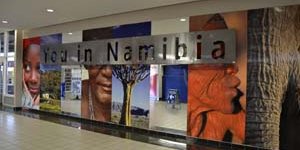Like this article?
Go on, give it a kudu!

Published on May 09 2019
Written by:
yourafricansafari.com
1967 views
Serengeti sees over 300,000 safarians each year; Katavi, about 1,000. Two weeks in Mahale/Katavi are possible on budgets not that far above a Serengeti and Ngorongoro visit. Often, we'd skip a drive altogether and watch the amazing animal theater from our camp site.
For over half a year I have abstained from writing this article, because of a strong feeling that I shouldn't. Just as a good guidebook may omit a local hangout spot to keep it from being overrun by tourists, I kept thinking that perhaps not telling anyone about our experience in western Tanzania was the right thing to do. The reason wasn't that I was selfishly hoping to keep visitors out of Mahale and Katavi. Let me explain, these national parks are in a league of their own.
There is good reason to try and conceal from everyone what the above two places are like. The national parks of Mahale Mountains and Katavi are a world apart from the most famous safari destinations such as Ngorongoro and Masai Mara. The key difference isn't in the landscapes or wildlife; it's in the number of visitors. Serengeti sees over 300,000 safarians each year; Katavi, about 1,000 (with half of them local Tanzanians).
These two orders of magnitude have serious consequences. In the peak of the tourist season in Ngorongoro up to $80 US may descend onto a single poor cheetah, turning the whole experience into something like a zoo. In contrast, during our six days in Katavi, we would get excited if we saw another vehicle in the distance; cars being rarer and harder to spot than elephants or giraffes.
Seldom visited doesn't mean undeserving—it just means hard to get to. Because we went in October, at the very end of the dry season, it seemed as if all the big animals in Katavi had congregated by the remaining water pools. We camped a few feet from the bank of one such pool with hundreds of hippos squeezed into it.
During the night, they would come out and walk miles in search of grass to eat, periodically brushing against our tents and waking us up. As long as you're inside a tent, most animals ignore you. The only time we really freaked out was when an elephant was munching on the branches of the tree that our two tents were next to.
Unlike the typical 40-mile game drives in search of wildlife in Serengeti, our longest was five miles; animal density is so high. Often, we'd skip a drive altogether and watch the amazing animal theater from our camp site.
One of the people in my group, the publisher of Russia's premier nature magazine, returned to Africa with a group of his own, two months ago. This time, he spent two weeks in all the parks of Kenya. He told me that after that, nothing compares to the density of animals we witnessed in Katavi National park
If Katavi is remote and seldom-visited, Mahale is more so. There are no roads, paved or dirt, leading to this park. The only options for getting there are by plane or boat.
Most people come to Mahale for chimp trekking, but I chose this destination for our group, based on Lonely Planet's descriptions; it being a destination farthest removed from the madness of Serengeti. I picked it because I wanted to sail down Tanganyika on a 1913 German-built MV Liemba ferry ($45.00 for a cabin, compared to $1,000.00 by charter plane). In fact, I was afraid that chimpanzee-trekking is a bit like bird-watching: something you really have to be into to enjoy. But now, having observed the chimpanzees in the jungle, I confess that this experience alone makes Mahale Mountains National Park a treasure.
I've seen chimpanzees in zoos before but peeking into their world for an hour is a different experience. It is jolting, awe-inspiring, mesmerizing. We still have recurring dreams from this encounter.
I wouldn't blame anyone who has been to Mahale and Katavi for trying to keep it a secret, however, that is not what has been preventing me from writing. I know how important national parks are for wildlife conservation. I realize how much thought the Tanzania Wildlife Authority puts into determining park quotas. I'm not afraid of Mahale being overrun by tourists and negatively impacting the chimpanzees. I have no fear that Katavi will become the next Ngorongoro circuit. What has really been paining me is the striking effect of tourism on the local Tanzanians, which is glaringly evident in Zanzibar and the northern circuit.
The markets in Kigoma and Mpanda, the day on the Liemba, the time in the villages of Sitalike and Ikola—over and over we came across helpful, proud, amazing people. No one asked us to pay for pictures, but time and time again, people asked us to take a picture of them. Kids didn't beg for money or pens; they just followed us around in excitement, deliriously happy and laughing every time we would say something. We had time and opportunity to talk to adults; there was sincere interest on both sides. Not once did anyone try to sell us something at the end of a chat. These may seem like simple things, however, they are a stark contrast to our ten days in Zanzibar, where all the negative warnings I heard from ex-travellers turned out to be true.
Two weeks in Mahale/Katavi are possible on budgets not that far above a Serengeti and Ngorongoro visit. The author went on safari with Lipi Adventure Company
Has been on: 15 safaris
Your African Safari (YAS) is a safari-planning resource for anyone planning an African safari. It features information on over 2600 tour operators including company and vehicle descriptions, user reviews, safari itineraries and photos. It also features detailed information on 14 countries and 84 parks and game reserves.
© Your African Safari Ltd, All rights reserved.
Your African Safari is a safari-planning and safari review site. It was created to help support a healthy African wildlife population. All reviews are vetted before being approved and only ethical tours are published

Garamba National Park—an anchor of hope in the Democratic Republic of Congo
Published on January 09 2025
By: R.W.

Namibia imposes new visa requirements
Published on July 25 2024
By: yourafricansafari.com

Do I really need travel insurance or travel protection for my safari?
Published on July 30 2024
By: yourafricansafari.com